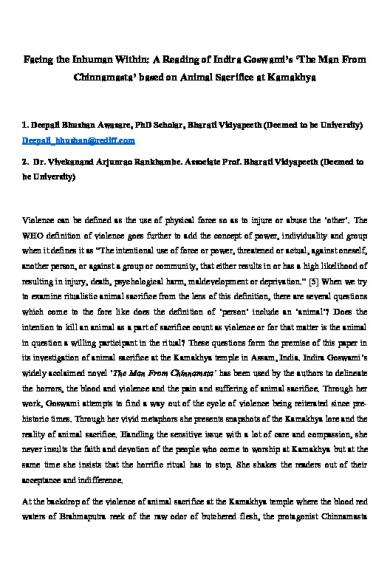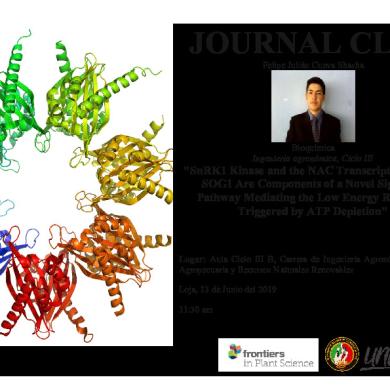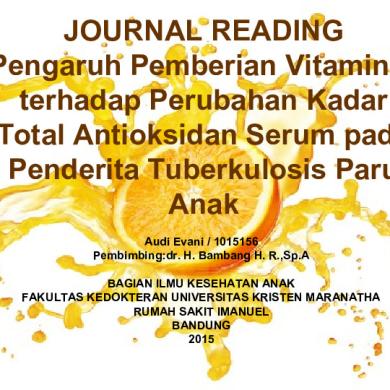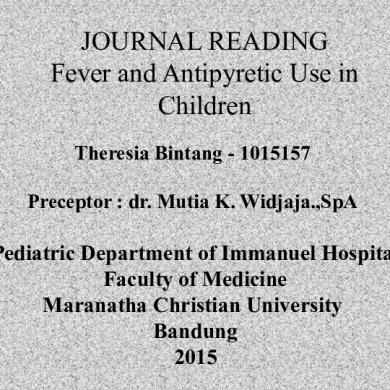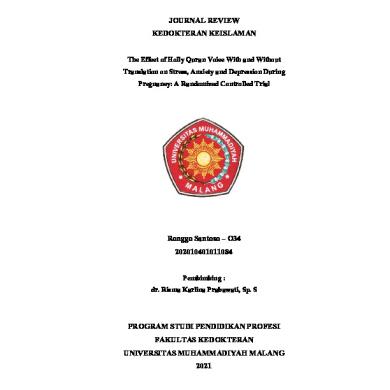Facing the Inhuman Within: A Reading of Indira Goswami’s ‘The Man From Chinnamasta’ based on Animal Sacrifice at Kamakhya
1. Deepali Bhushan Awasare, PhD Scholar, Bharati Vidyapeeth (Deemed to be University)
[email protected] 2. Dr. Vivekanand Arjunrao Rankhambe. Associate Prof. Bharati Vidyapeeth (Deemed to be University)
Violence can be defined as the use of physical force so as to injure or abuse the ‘other’. The WHO definition of violence goes further to add the concept of power, individuality and group when it defines it as “The intentional use of force or power, threatened or actual, against oneself, another person, or against a group or community, that either results in or has a high likelihood of resulting in injury, death, psychological harm, maldevelopment or deprivation.” [5] When we try to examine ritualistic animal sacrifice from the lens of this definition, there are several questions which come to the fore like does the definition of ‘person’ include an ‘animal’? Does the intention to kill an animal as a part of sacrifice count as violence or for that matter is the animal in question a willing participant in the ritual? These questions form the premise of this paper in its investigation of animal sacrifice at the Kamakhya temple in Assam, India. Indira Goswami’s widely acclaimed novel ‘The Man From Chinnamsta’ has been used by the authors to delineate the horrors, the blood and violence and the pain and suffering of animal sacrifice. Through her work, Goswami attempts to find a way out of the cycle of violence being reiterated since prehistoric times. Through her vivid metaphors she presents snapshots of the Kamakhya lore and the reality of animal sacrifice. Handling the sensitive issue with a lot of care and compassion, she never insults the faith and devotion of the people who come to worship at Kamakhya but at the same time she insists that the horrific ritual has to stop. She shakes the readers out of their acceptance and indifference. At the backdrop of the violence of animal sacrifice at the Kamakhya temple where the blood red waters of Brahmaputra reek of the raw odor of butchered flesh, the protagonist Chinnamasta
Jatadhari is like “an ancient landmass arising from the waters covered by an assortment of moss, creepers and grass”. [3] The ascetic Jatadhari’s chants and meditation in the Yoni mudra transcend the human consciousness and represents all of divinity. This very ‘inhuman’ ness of the protagonist and the deep communion which he has with the “Other” within him, makes him compassionate, and rise in protest against the ritualistic animal sacrifice at Kamakhya!
Animal Sacrifice at Kamakhya The Kamakhya Temple is one of the oldest of the fifty one Shaktipeeths, located in the Nilachal Hills in Guwahati, Assam. The Shakt sect of Hinduism worships the feminine aspect of God, the Shakti, as the universal cosmic energy. The Goddess Shakti has both the benign (saumya) and beautiful (sundar) form of the Sri kula (Family of the Sri) and the terrifying (ugra) and horrifying (ghora) form of the Kali kula (Family of the Kali). The Kali kula reveres the fiercely protective aspect of the Shakti, the Kali, who is dark skinned, has pointed teeth and a bright red tongue, and is adorned with a necklace of skulls. Her worship or sadhana is not devotional but tantric in nature having distinctive rituals which are symbolic like the ritualistic animal sacrifice which symbolizes the Goddess slaying a buffalo demon. At the Kamakhya temple animal sacrifice is an essential component in expressing devotion to the Goddess, and involves the slaying of buffaloes, goats and birds such as hens, ducks and pigeons. The devotees bring the animal to the priests who bless it and declare it as an offering to the Goddess. The meat of the animal is distributed among the devotees as prasad or blessing and it is cooked and eaten by all. The Tantric fertility festival called the Ambubachi Mela is also celebrated at the Kamakhya temple during the month of June corresponding to the monsoons. It is believed that the Kamakhya devi is undergoing her annual menstrual cycle and the temple remains closed for three days and when it opens on the fourth day, the devotees are given a prasad of water and a piece of red cloth symbolizing the menses of the Goddess. The animal sacrifice and the Ambubachi Mela are important events in the book ‘The Man from Chinnamasta’. The tantrik in the novel says, “Deliverance comes only when sacrifice is offered. Sacrifice alone will lead you to heaven. A buffalo’s blood quenches the goddess’s thirst for one hundred years. And when a follower offers the blood of his own body she is satisfied for one thousand years.” [3] The devotees come to the temple to offer sacrifices and rid themselves of
illnesses and to atone for their sins, or to seek blessings on the occasion of marriages, births and auspicious events, and some who want to display their wealth sacrifice more than one bulls! The spectacle of sacrifice at the Kamakhya is very violent and the writer Indira Goswami describes it in no uncertain terms. The novel begins by the images of the mighty Brahmaputra river; her expanse shaped like a machete and her blood red waters reeking of the raw odor of butchered flesh. There are numerous passages where the pain and suffering of the animals is vividly depicted. “The animal tried to break free as it was being hauled away to the slaughterhouse. It wanted to escape the death that came in the form of pilgrims. But the harbingers of doom kept tugging at it. Shoveling. Yelling. Prodding.” [3] Another gut wrenching festival mentioned in the novel is the Deodhani or the deodha nach; the shamanistic dance. The deodhas or the shamans are the men who are possessed by a deity and they echo the voice of the deity herself. The deodhas of the Goddesses Manasa and Kali are the most potent and most fierce. This dance ritual is celebrated for three days from 17 to 19 August every year and the preparations for it are on from June itself. The deodhas dressed in red garments with their bodies covered in vermilion and blood of the sacrificial animals dance intoxicatedly to the beat of many drums while the crowd gathers to worship them, offer garlands and wash their feet. This is the festival where the deodhas are in communion with their deities and have supernatural powers to cure all ailments and problems of their devotees and to please them the devotees offer goats, hens and pigeons. Goswami writes. “Kali’s deodha flicked his long tongue, red with the blood from the sacrifices of last night. Raising his arms, head bowed, he began to dance. Now and again he cast an eye on the assembled devotees. His glance filled their hearts with terror.” [3] The deodhas often carry goats on their shoulders and long machetes which they use to sacrifice the animals and sometimes they also use their teeth to kill the animal and drink its blood as is mentioned in the novel, “A devotee dragged a black goat up to the altar. Face down before the deodha, he dedicated the goat, pleading for release from some terminal illness……………. Then, without warning, the deodha sank his teeth into the goat’s neck. As the goat bleated, struggling to free itself, drops of blood fell on the ground.” [3] The character Dorothy Brown in the novel asks “What sort of worship is this? What sort of deliverance is this?” [3] Her heart beats with the click of the hooves of the buffalo being dragged on the stone path; a path which is as hard and cold as the hearts of the men dragging it. She can
see the mournful eyes of the animal shining in the night. She has no peace of mind. The ascetic Chinnamasta Jatadhari agrees, “We hold our souls together with the skins of sacrificed animals. No peace of mind.” [3] The ritualistic animal sacrifice at the Kamakhya temple is part of the nitya puja or everyday worship wherein one animal per day is sacrificed to the goddess before the temple doors open. During the Durga puja in the month of October every year and also during the Deodhani festival in the month of August every year, about 20 buffaloes, 3000 goats and innumerable birds are sacrificed on a single day! The priests of the temple claim that the worship of the goddess is associated with animal sacrifice and since it is part of the Vedic Hindu ritual it cannot be stopped. He adds that it is voluntary and when devotees come to sacrifice before the Maa, they have no right to stop them! The right to practice religious traditions is a Constitutional Right and does not come under the purvey of the Prevention to Cruelty of Animals Act of 1960. The state governments of Karnataka, Kerala, Gujarat, Tripura, Orissa, Himachal Pradesh, Telangana, Tamil Nadu, Rajasthan, Pondicherry and Andhra Pradesh have put in place the Animals and Birds Sacrifice Prohibition Act but the animal sacrifice in other states goes on undeterred. Thus the ritual is a tangle of religion, history, culture, discourse and power along with the material realities; the actual loss of life and the very real flesh and blood which stains the foundations of Kamakhya and the lives of her devotees. The ‘Inhuman’ within the human There have been many protests against the ritualistic animal sacrifice in India and elsewhere in the world, yet the killing at Kamakhya goes unabated. There are many reasons behind its continuance viz the market for buying and selling live animals and their hides is huge and generates profits, the revenue generated by the devotees and tourists too is significant and last but not the least, the unshakeable religious belief of the devotees that the ritual is a part of the Vedic texts and hence gives a moral excuse to its practitioners! The validation of the ritual by priests and the interpretation of the Vedic texts makes the sacrifice moral but at the same time it distances us from the actual pain and suffering of the sacrificial animal. It makes us numb to it! It is this distancing which makes the devotee walk with folded palms, lips uttering prayers, eyes unseeing the guillotine of the sacrificial altar and ears not registering the terrified cries of the animals.
There is such a profound difficulty in our relationship with animals! William James wants us to see these ‘difficulties of reality and the difficulty of human life in its relation to that of animals” and the “horror of what we do and the horror of our blotting it out of consciousness.” [4] A recent news item prohibits the sacrificial killing in the ‘open’ on the Kali ghat on Kolkata as the sight of flesh and blood and the odor of the raw flesh and offal hurts the sensibilities of the people and pollutes the waters of the river! Hence the government has demarcated areas which are secluded from the public eye to carry out the ritual. The animal here is reduced to its flesh and blood and stinking and polluting offal. The difficulty here is that the same animal is also the connection between the Goddess and the sacrificer, which will heal and protect the sacrificer of bodily harm. Cora Diamond suggests that instead of debating on how to treat animals, it is this difficulty in our relationship with animals that we must understand and acknowledge. She tells us to “imagine the bodily life of others” and have a “deeper understanding of the kind of animal we are and indeed the moral life of this kind of animal.” [2] The same ethos is in Goswami’s words when she writes the conversation between the ascetic Chinnamasta Jatadhari and a devotee at Kamakhya. He is dissuading the devotee from sacrificing the goats and says, “These are pure, beautiful, innocent lives. Put your ear to their breasts and you will hear the footsteps of Ma Kamakhya. Listen for yourselves. Listen to the Mother’s footsteps. The same rhythm the same rhythm that beats in your own breasts.” [3] This looking ‘within’ yourself is in congruence with the ‘atman’ (soul) and ‘brahman’ (realization or knowledge of the self) concept of the Upanishads. The idea of ‘inhuman’ is commonly associated with a lack of compassion or inhumanity but what if we recognize this very ‘inhuman’ -ness as the deep elemental connection between the self and the “Other”? Karen Barad, the theorist of Agential Realism, poses this question to open-up the discussion on responsibility, ethics and justice. She defines the inhuman as “ as an infinite intimacy that touches the very nature of touch, that which holds open the space of the liveliness of indeterminacies that bleed through the cuts and inhabit the between of particular entanglements.” [1] Thus the ‘inhuman’ can be defined as the primal essence of life which runs through all material bodies and reverberates as a hum in the Universe. The idea of the self as the “atman” and the “brahman” as a lively nothingness defined in the Indian philosophy relates to Barad’s concept of void as “the infinite in/determinacy at the heart of matter, the abundance of
nothingness, the infinitude of the void”. [1] Thus, the self and the “Other” became inseparable at an elemental level and recognizing that the self exists because of the “Other”, makes us aware that the elemental otherness is very much related to our own. Conclusion In our efforts to find a way out of the violence in our societies, it is necessary to understand our relationship with the others which co-habit and co-exist with us. The individual human self is inseparable from the other at the elemental level and recognizing that the self exists because of the “Other”, makes us aware that the elemental otherness is very much related to our own.. For modern Hinduism to evolve with the changing world we need to resolve and recover our past; reinterpret and re-imagine it in concordance with Gandhian techniques of sacrifice like the Ahimsa (non violence), Satyagraha (insistence on truth), fasting and meditation.
References [1] Barad, Karen. "On touching—The inhuman that therefore I am." differences 23.3 (2012): 206-223. [2] Diamond, Cora. "The difficulty of reality and the difficulty of philosophy." Partial Answers: Journal of Literature and the History of Ideas 1.2 (2003): 1-26. [3] Goswami, Indira, The Man From Chinnamasta. Trans. Prashant Goswami. New Delhi: KATHA 2006. Print. [4] James, William. The varieties of religious experience. Vol. 15. Harvard University Press, 1985. [5] https://en.wikipedia.org/wiki/Violence
